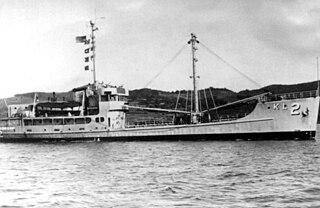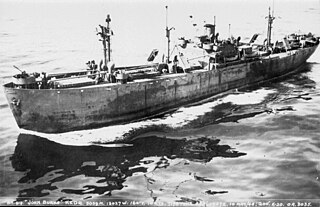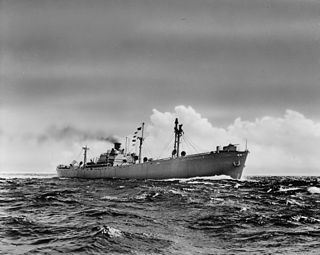
USS Longshaw (DD-559), a Fletcher-class destroyer, was a ship of the United States Navy named for Dr. William Longshaw, Jr. (1836–1865), who served in the Navy and was killed during the Civil War.

USS Gansevoort (DD-608) was a Benson-class destroyer in the United States Navy during World War II. She was named for Commodore Guert Gansevoort.

USS Deal (AG-131/AKL-2) was constructed for the U.S. Army as U.S. Army FS-263 shortly before the end of World War II and later acquired by the U.S. Navy in 1947. She was configured as a transport and cargo ship, classed by the Navy as a Camano-class cargo ship and operated with the U.S. Pacific Fleet from post-World War II and on through the end of the Korean War.
USS Ryer (AG-138/AKL-9) was a Camano-class cargo ship constructed for the U.S. Army as the Freight and Supply Ship USA FS-361 shortly before the end of World War II. On delivery the ship was U.S. Coast Guard crewed and assigned to serve the Southwest Pacific area during the war. The ship was acquired by the U.S. Navy in 1947, configured as a transport and cargo ship, named and was Commissioned, Miscellaneous Auxiliary, USS Ryer (AG-138), 8 June 1947 and reclassified Light Cargo Ship, (AKL-9), 31 March 1949.

USS Hewell (AG-145/AKL-14) was a Camano-class cargo ship constructed for the U.S. Army as FS-391 shortly before the end of World War II. FS-391 operated with a U.S. Coast Guard crew in the Southwest Pacific area. The ship was acquired by the U.S. Navy in 1948. She was configured as a transport and cargo ship and served with the U.S. Pacific Fleet – including highly decorated service during the Korean War – until decommissioned in 1955.

USNS Range Recoverer (T-AG-161/T-AGM-2/YFRT-524) was a missile range instrumentation ship responsible for providing radar and/or telemetry track data on missiles launched from American launch sites.
USNS Shearwater (T-AG-177) was a Shearwater-class miscellaneous auxiliary built during the final months of World War II for the US Army as FS-411 by Hickinbotham Brothers Shipbuilders. FS-411 was Coast Guard manned operating in the Central and Western Pacific, including Hawaii, Saipan, Tinian, Guam, during the closing days of the war.

BRP Mangyan (AS71) is an auxiliary ship of the Philippine Navy, formerly the freight supply ship U.S. Army FS-524, built for the United States Army during World War II.

USNS New Bedford (FS-289/AKL-17) was a Navy owned Military Sea Transportation Service civilian crewed Camano-class cargo ship originally constructed for the U.S. Army as the coastal freighter FS-289 shortly before the end of World War II.
USCGC Nettle (WAK-169) was a United States Coast Guard Design 381 coastal freighter acquired from the United States Army and was designated as USA FS-396 during World War II army operations. She was transferred to the United States Coast Guard in 1947, and used for servicing aids to navigation and providing logistics support for U.S. Coast Guard manned LORAN stations in the Pacific Ocean.
The Shin'yō Maru incident occurred in the Philippines on September 7, 1944, in the Pacific theater of World War II. In an attack on a Japanese convoy by the United States Navy submarine USS Paddle, 668 Allied prisoners of war were killed fighting their Japanese guards or killed when their ship, Shinyō Maru, was sunk. Only 82 Americans survived and were later rescued.

SS John Burke was an American Liberty Ship built during World War II, one of the 2,710 type 'EC2-S-C1' ships that carried all kinds and types of dry cargo during the war. The ship was named for John Burke, the 10th Governor of North Dakota. Burke was built at Kaiser Shipbuilding Company's Oregon Shipbuilding yard in Portland, Oregon. Burke's keel was laid November 20, 1942 and the hull was launched on December 13. After fitting-out, Burke was delivered to the US Maritime Commission on December 23, just 33 days after construction began. The War Shipping Administration then placed Burke under management of the Northland Transportation Company.

SS William S. Ladd was an American Liberty ship built during World War II, one of the 2,710 type 'EC2-S-C1' ships that carried all kinds and types of dry cargo during the war. She was named for William S. Ladd, an American politician and businessman in Oregon, who twice served as Portland's mayor in the 1850s. The ship's keel was laid on August 29, 1943, and 15 days later, on September 13, the hull was launched. William S. Ladd was fitted out in seven days, and was delivered to the U.S. Navy on September 20. The Navy placed Ladd under charter to Weyerhaeuser Steamship Co.

The USS Banner was originally U.S. Army FS-345 serving in the Southwest Pacific during the closing days of World War II as one of the Army's United States Coast Guard crewed ships. In 1950 the ship was acquired by the Navy and converted into a light auxiliary cargo (AKL). In 1967 the ship was converted for electronic intelligence and reclassified as Auxiliary General Environmental Research (AGER).
Piso Point is a former Japanese naval base throughout World War II which is located at the eastern portion of Davao Gulf, across from Davao City, Philippines. It was also a harbor for Japanese suicide boats which had been harassing American shipping in Davao Gulf. During the liberation of the Philippines from the Japanese on May 14, 1945, many of the Japanese suicide boats were annihilated by the U.S. Navy.
HMS LST-422 was a United States Navy LST-1-class tank landing ship that was transferred to the Royal Navy during World War II. As with many of her class, the ship was never named. Instead, she was referred to by her hull designation.

Alhena (AKL-38) was a Design 381 built for the United States Army as FS-257. The Army vessel was U.S. Coast Guard crewed, serving in the Southwest Pacific during World War II.

USS YF-444 was an American YF-257-class covered lighter built in 1944 for service in World War II. She was later acquired by the United States Coast Guard and renamed USCGC White Sage (WAGL-544).












